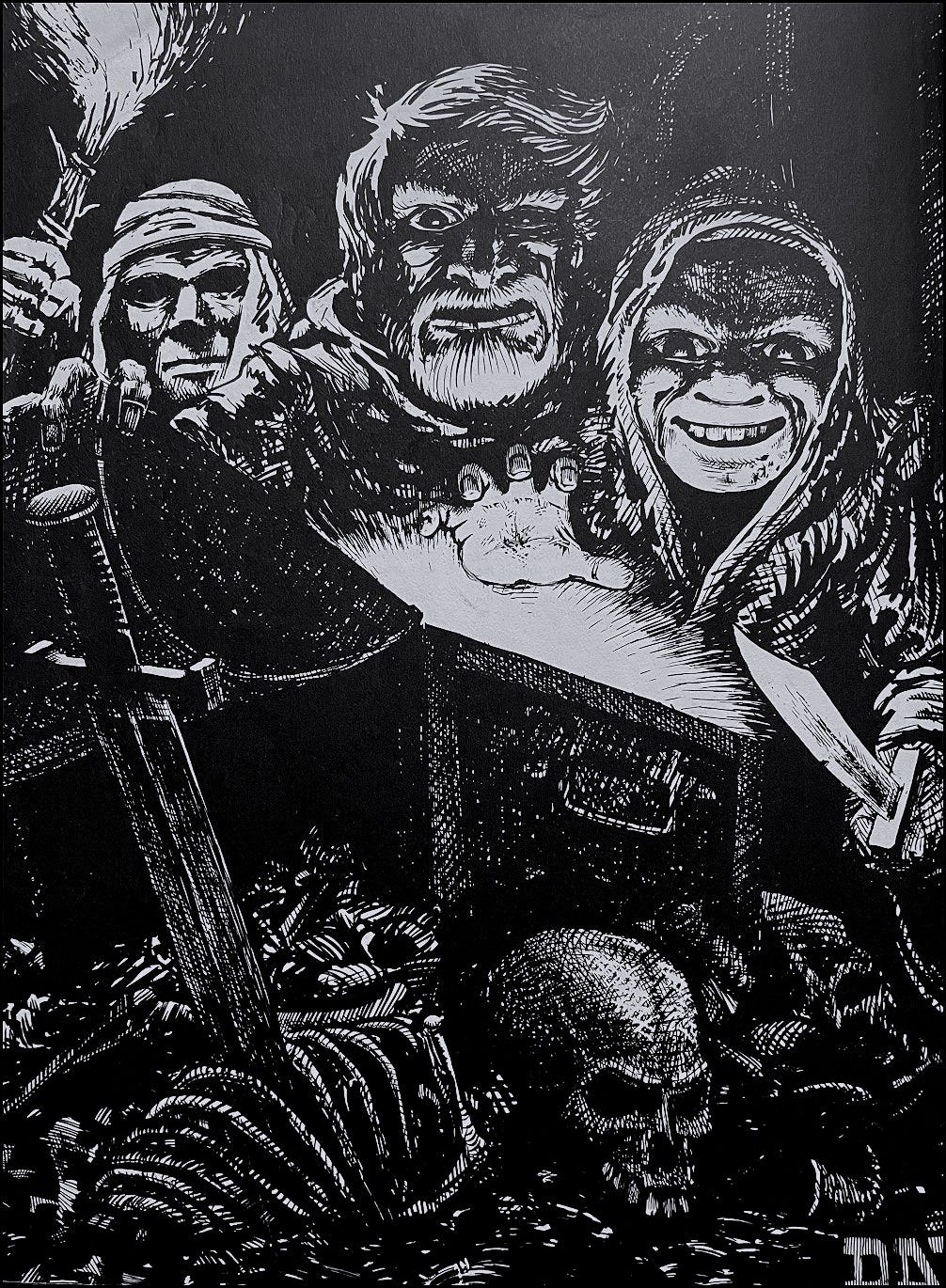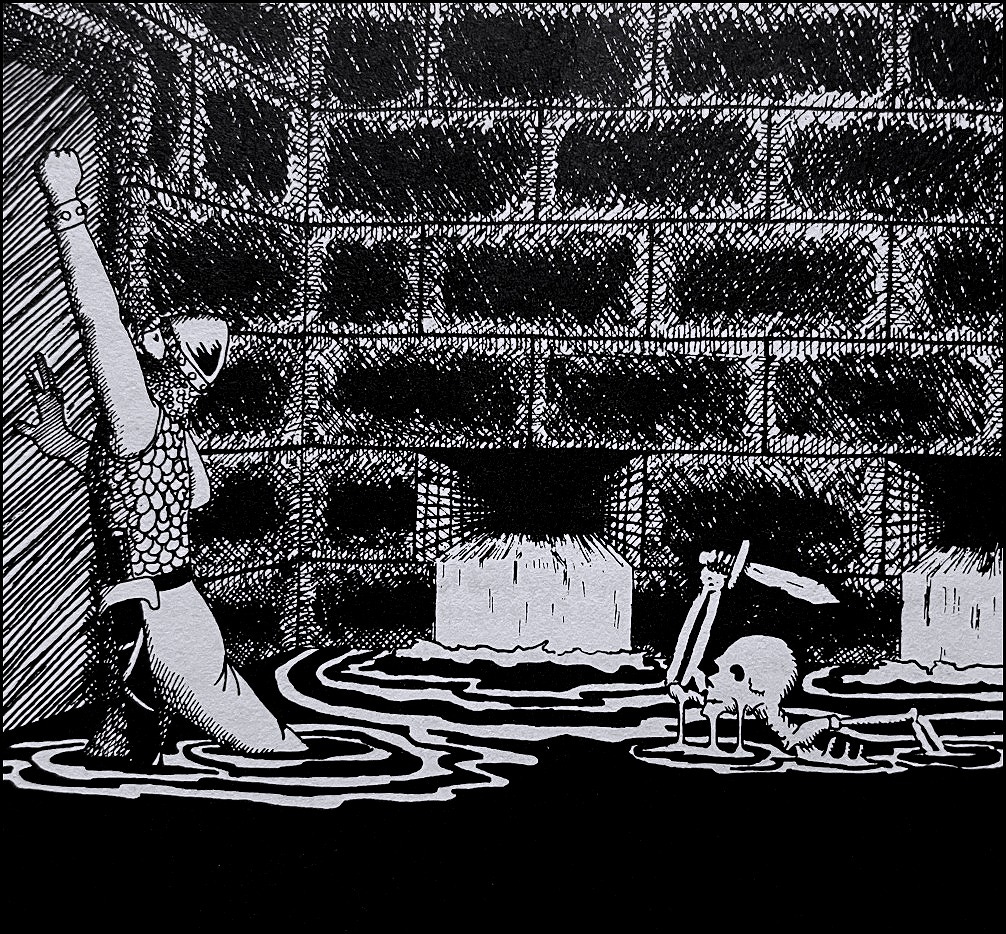For Anyone Caught Sticking Their Hands in the Treasure Chest
On the thieves, rogues, and assorted trap-solvers in your tabletop games.
Following our look at G.I. Joe’s Tripwire and bomb diffusers in fiction, we continue exploring that character/role in TRPGs.
In the context of G.I. Joe, the opposite to Tripwire is likely Firefly. Trap-detector/trap-setter. And just as it can be easier to take the perspective of the trap-detector in story-telling, TRPGS have also tended to emphasize that side of things as well. After all, adventurers are the ones exploring the dark, forgotten crypts and dungeons of the world, carefully tapping their way ahead with a 10’ pole.1
It’s the Dungeon Masters setting the traps for them to stumble into. So let’s explore more of the class devoted to foiling their fiendish devices!
A Brief History of the Thief
And I do mean brief, because I largely do not know whereof I speak.
I mostly play warlocks…2

The Thief of Dungeons & Dragons
1st edition D&D had its thief class3, and while their skills included finding/removing traps, it’s unclear to me if other classes could make less proficient attempts as well (sorting through those rules is it’s own kind of dungeon, but here’s a good discussion).
As written, dwarves could at least find stonework traps, and elves could find secret doors, but if a party didn’t have a dedicated thief on hand, just how screwed were they? Presumably clerics needed to stockpile 2nd level find traps spells, but that didn’t help with trap removal, just their detection and avoidance.
Logically any character could state what actions they’d take to look for traps, tapping the ground ahead with 10’ poles or whatever other specific action might permit them to find one. With the introduction of thieves, these attempts seem to shift from a required narrative description of how the party was searching, to a simple dice roll determining success or failure (a change in gameplay that looks to be reversed in Dungeon World).
Later editions would allow other classes the clear possibility of finding/removing traps. In 3e D&D, for example, any character could attempt Search checks to find simple, non-magical traps, and Disable Device checks to remove them; thieves (renamed rogues) had higher skills to so generally, as well as specialized abilities to find/remove more advanced and magical traps.
Similarly in 5e, characters could likewise use their Perception or Investigation skills to find, and their Dexterity ability to remove traps. Thieves (rogues) had better training in these skills as well automatic proficiency with thieves’ tools to make the job easier.

In Other Systems
In so far as I’ve been reading through other systems, including OSR systems, here’s generally how traps seem to operate (and again, please correct me if I’m wrong):
Dungeon Crawl Classics: Thieves can find/remove traps. Other characters can use their Intelligence for “searching and spotting” but I’m uncertain if this includes specifically includes traps. As a DM, I’d rule that it could; after all, most of these rules seem to follow the same basic premise: adventurers can search for traps, while thieves are better at finding them and specially trained at removing them.
Dungeon World: Running the Powered by the Apocalypse system, this is furthest out of my wheelhouse. Still, the base comparisons are similar. All characters can search for traps, but only thieves can both find and remove them. This seems handled by having thieves able to ask more specific questions in the searching phase, with the system’s general promotion of narrative discussion over dice rolling.
Old School Essentials: Any character can search for a room trap (1-in-6 to find), with dwarves excelling at non-magical room traps (2-in-6). Thieves have a further chance to find/remove treasure traps (such as on chests and doors).
Shadowdark: Any character can search for traps, and if they know exactly where to look will automatically succeed. Thieves can find and remove traps, both with advantage on such checks (rolling twice and taking the higher roll).
A Thief By Any Other Name…
Essentially, the goal of the above systems is to ensure that any adventuring party isn’t neutralized by not including a thief. Characters are adventurers after all, experienced in traveling through dangerous, trap-laden areas. They already know a thing or two themselves about pressure plates and covered pits. At the same time, their skills can’t become so advanced as to completely water down the utility of having an actual thief along.
But considering that each class deserves its own unique role, there may be added ways to allow a thief to shine even more; they don’t just find traps better than other characters, they can do so in ways uniquely their own.
Some further options:4
When attempting to find traps, a thief is particularly adept at examining the remains of past victims, no matter how old, to help discern how the trap works. Likewise, they are able to locate these remains in hidden gutters or wells that many traps employ, especially resetting traps, in order to recover gear or loot.
If a thief fails to disarm a trap, they still have a chance to delay its release. In this case, they jam the trap mechanisms in such a way that might allow the party to outrun its effects (such as explosion or release of poison gas), or at least try to “catch” or pull back the person who set it off (such from falling into an opened trapdoor, or away from a falling portcullis, etc.).
A thief may not only attempt to disarm, but at higher levels even rearm or “harvest” a trap. To rearm a trap, a thief effectively resets it such that the party’s bypass is not detected (while also keeping the trap in place to catch any pursuers). To harvest a trap, a thief is able to remove the trap itself, if small enough, to later reset for their own use. If too large or integrated, a thief may still remove key components, such as its trigger mechanism, poison needle, or other features for later use.
In addition, just as scrolls and spellbooks are highly prized by magic-users (and treasure maps by just about everyone), so too are schematics for various traps. A thief that successfully disarms a trap may also attempt to record its operation through notes and sketches; depending on the uniqueness of the trap, such a schematic can be sold for various amounts in the cities and thief guilds of the world.
At higher levels, a thief of great renown is able to employ their skills beyond mere trapwork. They can also make attempts to deactivate golems and magical constructs, deactivate magic items (at least temporarily), disable stationary spells (e.g., magic mouth, symbol, teleportation circle, etc.) and have the inherent knowledge to identify the powers of an artifact… not to mention, thieves at high enough level can recognize a mimic from an ordinary chest at a mere glance!
As a final note, I witnessed two separate incidents at this year’s JoeFest. First, there was a broken water line at a local distillery. The poor bartender had to serve drinks while standing in a growing puddle.5 (In a way, recreating that flooding room trap illo, above).
The second was how, at just about every con, there’s the challenge of connecting and reconnecting A/V equipment between panels running one right into the next. There wasn’t time to get set up for the next panel, causing a small delay in figuring out the right connections for the next group’s slideshow.
The point being, as a DM you might find creative ways for a thief to use their find/remove trap or related skills outside of the dungeon as well. Allow them opportunities to help in small ways that can still influence people; for example, the above bartender need not be bribed for information if the thief can disable a leaky tap with their tools!
Recommendations
For a solid and comprehensive exploration of the ultimate trap-filled dungeon, the Tomb of Horrors, head to
; they have an excellent write-up including a look at its essential illustrations.Plus, two folks that have come over to Substack:
and (who recently posted on dungeon-relate items with In Praise of the Iron Spike.I had the chance to visit one of the best bookstores I’ve stepped foot into, The Book Rack on Whidbey Island, where I purchased Gamemasters: A Comic Book History of Roleplaying Games. I missed its Kickstarter campaign, but it’s available now and highly recommended.
Just finished watching Ryan Coogler’s Sinners. And while I didn’t find it a particularly scary film (which was actually a good thing for me), a bit too gimmicky with Michael B. Jordan playing twins, and a bit too tropey in how to dispatch vampires, I found its use of music absolutely stunning and worthwhile for that element alone. And I am not a musical fan.
I am, however, a sucker for Irish vampires and Celtic lore in general. Which leads me to my final note…
ARC Readers Wanted
I am incredibly thrilled to be nearing publication of my dark fantasy novel. If you’re interested in becoming an ARC reader, please head right over here!
Next time: It’s either going to be Flash/Grand Slam or that goddamn embarrassing idiot known as Dr. Mindbender.
I loved how this became a part of dungeoneering equipment, and I don’t know if it’s from the game being cheeky (playing off the expression “I wouldn’t touch it with a 10’ pole), or going back to actual equipment that this expression derives from (long barge poles or even earlier Roman measuring poles, the decempeda).
Call them rogues all you want, they’ll always be thieves to me! Han Solo’s a rogue; Bilbo Baggins is a thief. In the politest sense of the word, of course. I may also be biased; when I started at Wizards of the Coast and worked on the Star Wars TCG, I kept misspelling the Rogues & Scoundrels expansion as “Rouges” and Scoundrels. Chris Perkins, I remember, pointing that one out to me as well (shortly after the Vader’s Helmet incident).
For reference, read Jon Peterson’s Playing at the World. In it, he relates the genesis of the thief class as coming from a play group out in California. Or at least the idea; Gary Gygax wrote of then developing the initial rules in a pre-Dragon Magazine newsletter.
Not all of which are exactly original, and have likely appeared in some mention of thief skills through the various editions. But so be it, I wanted to jot some thoughts down anyway!
It was the Second City Distilling Co. Bless that bartender!




